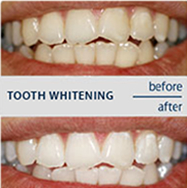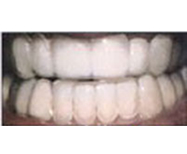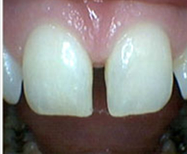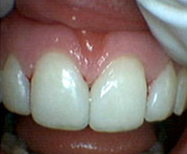Cosmetic Dentistry
Tooth whitening

There are two ways patients can choose to bleach their teeth: home or office bleaching. Home bleaching involves the fabrication of plastic mouthpieces that look like protective sport mouth guards. The patient then must wear these mouthpieces with a hydrogen peroxide based bleach for two to four hours a day for four to eight days.
Only natural tooth structure responds to bleaching. Fillings and porcelain will NOT bleach. Patients need to consider this before bleaching because significantly whiter teeth may cause your old porcelain and/or bonding to look fairly yellow.
Instructions for Home Bleaching
Bleaching is used to enhance your smile by brightening your existing natural teeth. When you start to bleach we typically have you bleach your upper teeth first when you are bleaching both upper & lower teeth. This will provide you with a comparison so you know just how much your teeth are whitening. Bleaching usually takes 1-2weeks for the complete result. We cannot predict the exact level of shade changes you will have with bleaching, but it will always make your teeth lighter.
 Placing Gel
Placing Gel Wearing Tray
Wearing Tray
Instructions:
- Brush and floss teeth thoroughly prior to placing the tray in your mouth.
- Place small drop of gel in tray at each tooth site where whitening is desired.
- Seat tray completely and firmly onto teeth.
- Wipe off excess gel with cotton or clean finger.
- Trays are to be worn over night.
- When trays are removed, rinse with cool water and remove residual material and store in case.
- Brush and rinse remaining gel from teeth after Bleaching.
- Remove tray prior to eating.
- You will have enough material to bleach both upper and lower teeth for 1-2 weeks.
Space Closures
The Origin of Gapped Teeth :
Each person is unique, and no one case presents a definitive reason why a space is present. Genetics can play a major role in how teeth form in your mouth. If your parents have spacing between their teeth, it is a good chance that you will also.
Childhood habits largely affect the position of your teeth as well. Breathing mostly through your mouth and sucking on your thumb are examples of habits that will affect the position of your teeth.
Adults can also have habits, like forcing their tongue against their upper teeth or pen biting, that can gradually shift teeth throughout life. When the teeth shift, spacing or even jaw joint pain can occur.
How to Correct the Spaces Between Your Teeth :
There are four ways to correct the spaces between your teeth. Diagnosing the reason the spaces are present will determine which of the treatments will best suit your needs.
 before
before after
after
Gaps between teeth can be filled by:
- Orthodontics (moving the teeth)
- Bonding (bonded tooth-colored fillings)
- Dental Veneers/Laminating (bonded porcelain facings)
- Dental Crowns (capping)
Placing braces on your teeth in order to move them into their correct position is usually the most ideal treatment. Using orthodontics to move the teeth is the most time consuming, but it is also the most beneficial. Orthodontics is used to place teeth so that your bite is in harmony with your smile.
All of the other treatments to fill the spaces, including tooth bonding, dental veneers, and dental crowns, although they are very good treatments, are considered esthetic and functional compromises, and should be discussed with us in order to determine which restorative dentistry treatment is best for you.
